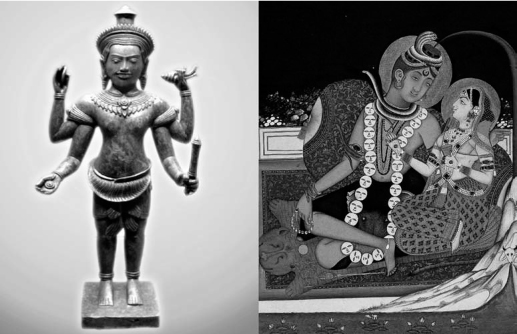Indian MythologyThe Hindu Pantheon |
What is the Hindu pantheon? |
The Hindu pantheon changes and develops over time. In the early Vedic tradition, Dyaus (Dyaus Pitar = Father Sky, the Greek Zeus and the Roman Jupiter) and Prithvi (Mother Earth) are, like Uranos and Gaia in Greece, the original deities. They are followed by a second generation of devas (deities) led by Indra. Indra, Surya (sometimes Mitra), the sun god, and Agni, the fire and sacrifice god, form the first of the great Hindu triads. Another important early figure is Varuna, sometimes the supreme deity, sometimes a god of the waters, sometimes representing night as opposed to Surya-Mitra’s day. Lesser Vedic gods are the Ashvins, the first of the many Indo-European sacred twins; Vayu, the wind god; Ushas, the goddess of Dawn; and Vac, the goddess of speech and “Mother of the Vedas” and wife of Indra. Vishnu and Rudra (a pre-Shiva), are only minor figures in the early development of what would become Hinduism.
During the period of the Upanishads, complex creative principles become embodied by Prajapati and, in an even more complex manner, by Brahman.
Eventually a second great triad or trimurti develops, in which Brahma is the creator, Vishnu the sustainer, and Shiva the necessary destroyer of the universe, which must undergo constant creation and recreation. Brahma’s wife is Sarasvati, Vishnu’s is Lakshmi or Sri, and Shiva’s is Pārvatī. Vishnu and Shiva remain dominant in classical Hinduism, but Brahma is essentially replaced in importance by Devi, the great goddess in her many forms, such as Durga, Kali, and Shakti, and in a sense any feminine incarnation such as the wives of the three gods of the Trimurti.
In addition to these major figures are a great number of lesser deities, among the most famous of whom are Ganesha (Ganapati), the elephant-headed son of Shiva and Pārvatī, and the many Manus and Prajapatis of various eras.

A Cambodian sculpture of Vishnu (left) from the eleventh or twelfth century; at right, an 1800 illustration of Shiva and Pārvatī.
